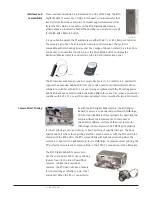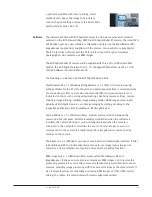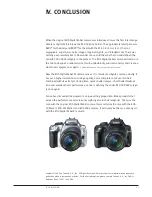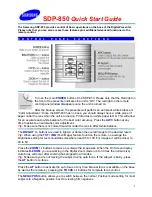
horizontally. The linear polarized light is converted into circular polarized light by the
phase plate. The second crystal plate separates the images vertically, resulting in four
duplicate images arranged in a square matrix. The image separation in the horizontal
and vertical directions is optimized for the sensor pitch so that false colors and moiré
caused by minute horizontal and vertical lines in the subject are reduced while resolution
is actually increased. Additionally, this hybrid construction, with its deflecting and
absorbing layers, reduces image fogging and red ghosting caused by sensor reflections.
The CMOS sensor features a second generation, on-chip, noisereduction circuit that
includes a new low-noise gain amp and an offset reduction circuit. The signal is
amplified in slow-read steps. The result is the effective elimination of random noise and
fixed pattern noise. With the EOS Digital Rebel XT camera, one can even photograph the
heavens in the night sky with very low noise.
To minimize the increase in power consumption caused by upgraded components such
as the larger sensor and the faster reading of the sensor’s output, the output amp’s
power consumption is kept to an absolute minimum. As with the EOS 20D, power to the
output amp is cut off and circuit-driving standard current is also cut off during long
exposures. Less power is used and noise is further reduced.
The DIGIC II Image Processor brings a host of significant
improvements in speed of operation, control, noise
reduction and image quality to the EOS Digital Rebel XT
camera. The camera starts up in a near instantaneous 0.2
second. Its shutter release lag time is now only 100
milliseconds and viewfinder blackout time has been
reduced to 175 milliseconds. The EOS Digital Rebel XT
camera can shoot up to 3 frames per second at its full
JPEG Large/Fine 8 megapixel resolution. The DIGIC II’s major reduction in buffer
clearance times and its huge increase in write speed to the CompactFlash card enable a
burst performance of 14 consecutive frames for 8 megapixel JPEG Large/Fine files and 5
consecutive frames for 8 megapixel RAW files.
The DIGIC II’s newly-developed algorithm also yields improve color reproduction,
especially with high-saturation, bright subjects, improved auto white balance precision
for a wide range of scenes and light sources, and wider dynamic range in highlight areas.
III. DISCUSSION
11
New DIGIC II Image
Processor
Fixed-Pattern noise-reduction
circuit
Low-noise high-speed amp
V
S
R
V
S
R
Fixed-Pattern noise-reduction circuit 1
Low-noise gain amp 2
Offset reduction circuit 3
Low-noise high-speed amp 4
1st-generation on-chip noise-reduction circuit
2nd-generation on-chip noise-reduction circuit
Noise reduction by
amplifying the signal
in slow-read steps
DIGIC II Image Processor












































